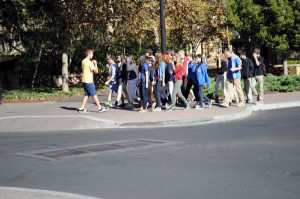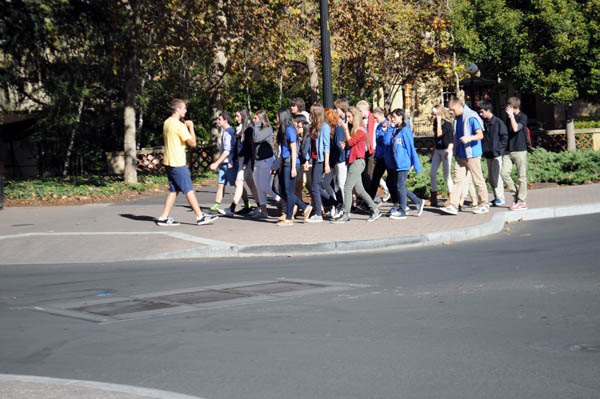
Stanford tour guides introduce over 100,000 visitors annually to the Farm through campus walking tours overseen by Stanford Visitor Information Services (VIS). And they do it all while walking backwards.
“You get to be the face of Stanford to the 20 people on your tour,” said tour guide Eric Mattson ’15. “It’s very gratifying, getting to show people around the campus. That has done a lot for me personally.”
“[Training] is pretty intensive,” said tour guide Kristi Bohl ’13. “It takes about two months from the point at which you are hired before you give your own tours…The VIS quiz is thorough and it goes point by point through all the major facts.”
To become a tour guide, students must go through training for most of spring quarter. VIS hires guides beginning in mid-March, giving successful applicants “the VIS Bible,” or the tour guide training manual. They then attend an orientation session, shadow five or six tours and are paired with a more experienced guide.
The most crucial tool in the tour guide kit is the training manual, a 200-page binder filled with facts about Stanford. It gives detailed information about Stanford academics, athletics, housing and student groups. And guides aren’t joking when they call it the bible: the manual’s preface includes instructions like “duct tape it to your torso” and “make it a part of you.”
Facts inside – such as “Did you know the Bookstore is the second-largest university bookstore in the U.S.?” – change from year to year.
“It’s based on the previous years’ manuals, and then every year we may add or take away depending on how things change,” said Christina Ziegler, VIS administrative associate. “For example, this year, the Thinking Matters program is coming out, so we’re going to kind of have to do a lot more than we would normally do to put together information about that for the guides.”
But not every tour will use the same facts.
“We try to give way more information than you would every give on a tour so you can kind of pick and choose what is important to share on each tour,” Ziegler said. “If it’s a group of third graders coming, facts that [tour guides] share are going to be different than if it is international businessmen coming, because obviously the group is going to have different interests.”
Guides continue professional development throughout their tour-guiding career. They practice public speaking, complete workshops on customer service and go on tours of specific areas of campus, such as Hoover Tower, to learn more detailed information.
Despite the training tour guides complete, some errors slip through. On a recent tour, a guide claimed human biology is the most popular major at Stanford, followed by computer science. Last year, though, 220 students declared a computer science major, making it the most popular major at Stanford. The guide also flubbed the total Stanford population, overestimating by several thousand students.
Errors with numbers may be the result of recalling over 200 pages worth of information while, of course, walking backwards. However, many errors stem from oversimplifications of University policies.
For example, one guide said that all sections for large lecture classes are capped at 16 students. Though the majority of large classes have small sections, larger sections of about forty students are also common.
Another maintained that Stanford offers need-blind financial aid for all students, though this is not true of international students.
Many of the tour guides use mistakes as learning experiences, taking their errors in stride so they can be more accurate in the future.
“It was actually not even a tour with other people,” Mattson said, recalling an instance of giving incorrect information on a practice tour. “I literally had no idea what to say, and so I just started babbling. That was a good learning experience. It prompted me to go back and make sure that what I’m saying is substantiated in the manual.”
